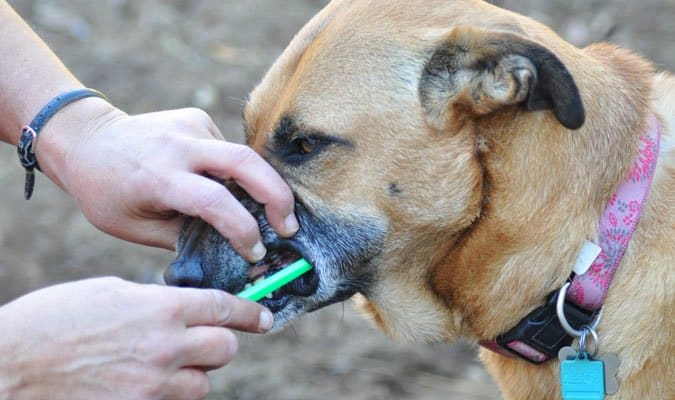It’s sometimes shocking to me that so many of us live with dogs and never think of looking at their teeth. Like us, dogs can develop problems with their teeth that can affect their overall health. But in comparison to us, their lives are much shorter – and they develop dental problems much more quickly. In fact, if these problems are neglected, they can actually shorten your dog’s life.

Cavities are the biggest problem for human teeth, but the accumulation of plaque and the development of tartar (also called dental calculus) is the most serious dental problem for dogs. Tartar builds up on the teeth, forming a concrete-like crust on the teeth at the gum line. It also forms under the gums, which helps bacteria get under the gums and proliferate. The resulting infection causes the gums to appear red, swollen, and irritated. This condition, also known as gingivitis, can lead to deeper infections. Infection can also damage the ligaments and bone that anchor the teeth, making them susceptible to loss. Because of the rich blood supply to the mouth, the infection can also spread systemically, making your dog quite ill and/or affecting his heart, kidneys, and liver. This chronic condition can prematurely age your dog.
The odd thing is, some dogs can go their entire lives and never need one bit of dental care in order to maintain white, strong, healthy teeth. But others need our intervention and help to keep their teeth in a state of health. Small dogs tend to have more problems with the formation of dental calculus than large dogs; it’s not uncommon for small dogs as young as five or six years old to have very dangerously tartar-encrusted teeth and infected gums.
Dogs may also have other dental problems that can’t be seen while the dog is awake, no matter how cooperative. Cracked or broken teeth can cause chronic pain – and the dog won’t necessarily show signs of this, such as a reluctance to eat – but he may be cranky and lose enthusiasm for play or work.
If your dog has discolored teeth, and tartar has begun to form along his gum line, he’ll need a professional cleaning at your veterinarian’s clinic to completely remove the tartar from both the surfaces you can see AND the under-gum surfaces you can’t. The veterinarian might also prescribe and supply you with antibiotics to give your pet after the procedure, to help your pet fight the bacteria that is released into his bloodstream by the cleaning process. The cleaning is done under general anesthesia; there is no other way to do a thorough job.
Once your pet’s teeth are clean, you can maintain that state with regular brushing. Use toothpaste made for pets; human toothpaste containing fluoride is toxic to dogs. Use a very soft toothbrush; most pet supply stores sell long-handled brushes with a head small enough to fit into the mouths of small animals. Start out slowly, keeping the process rewarding for your pet; give him ample treats for his cooperation. Ask your veterinarian to show you how.





